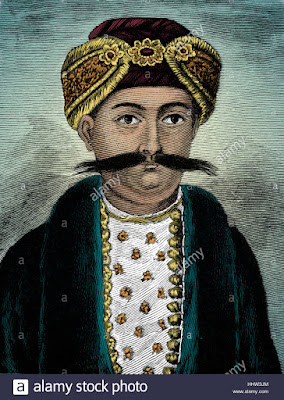 |
| entrance, Nizamat Imambara, Mushidabad, WB commons.wikimedia.org |
 |
| Nizamat Imambara, Murshidabad, Justdial |
 |
| Nizamat Imambara of Murshidabad , WB West Bengal Tourism |
The following are some interesting facts about the Nizamat Imambara. Murshidabad, West bengal:
01. The present. Nizamat Imambara, 2 km from the outskirts of Murshidabad town, West Bengal is not only the largest and most impressive of all Imambaras of Bengal but also the largest one in India.
02. There existed an old Imambara before the present one and it was partially damaged in 1842 and fully damaged in December 1946.
03. The interesting fact is the old Imambara was not made of brick and mortar, but of quality wood.
 |
| Nizamat Imambara, Murshidabad, W.Bengal. Wikimapia |
04. The cause of the fire accident was due to careless fireworks display at mid-night when a gala party, consisting of the Nawabi family and the Europeans, were rejoicing the weaning ceremony of five-year-old Hassan Ali Mirza.
05. Despite the total destruction of the Imambara, the erstwhile old Madina Mosque (now in the Hazardurai palace) in it was not affected.
 |
| Medina Mosque,Hazardurai palace complex, Murshidabad, WB .shutterstock.com |
06. The Madina Mosque is now in the midst of Hazardurai palace in Murshidabad and is well taken care of.
 |
| Nuilt old Imambara. Nawab Siraj-ud-daulah of Bengal Alamy |
Above image: Siraj ud-Daulah (1733 – 2 July 1757), was the last independent Nawab of Bengal. The end of his reign marked the start of British East India Company rule over Bengal and later almost all of the Indian subcontinent. He succeeded his maternal grandfather, Alivardi Khan as the Nawab of Bengal in April 1756 at the age of 23. Betrayed by Mir Jafar, then the chief of Nawab's army, Siraj lost the Battle of Plassey on 23 June 1757. The East India Company under Robert Clive later put Bengal under the Company (en.wikipedia. org) ..........................
07. The builder of the old Nizamat Imambara in the fort area is none other than Nawab Siraj-ud-daulah, the man who was purported to be responsible for the Black Hole incident (June 1756) in Calcutta (Kolkata). The confinement of the British in the dark cell at Ft. William by the ruler was unintentional. The East India company's refusal to pay tax arrears in violation of the trade agreement, their expansion and additional fortification of Ft.William in Calcutta without his permission and the abuse of trade privileges granted by the Mogul ruler by the company infuriated Nawab Siraj. The state incurred heavy loss due to EIC's breach of trust and this led to many confrontations with the English company's army.
08. The unique aspect of the old Imambara is it contains the soil from the holy land Mecca. The Nawabs's good intention was those poor people in the Muslim community who could not undertake the pilgrimage to Mecca -''the Haj''could experience it by visiting the Imambara.
09. The ruler himself laid the first foundation by placing the brick and mortar in the deep trench.
10. The new Imambara was built by Nawab Nazim Mansur Ali Khan in 1847 under the supervision and direction of well-experienced Sadeq Ali Khan just opposite the Hazarduari Palace. The cost of construction was more than ₹ 6 laks.
11. It took a short span of 11 months to complete this huge structure and the masons were paid fairly well besides free food. They put in extra hard work - day and night.
12. The new Imambara, a religious building, included a new mosque to serve the worshippers.
 |
| Built new Enambara, Nawab Sayyid Mansur Ali Khan. en.wikipedia.org |
Above image: Nawab Sayyid Mansur Ali Khan (29 October 1830 – 4 November 1884), the builder of this Nizamat Imambara was the Nawab of Bengal until his abdication in 1880. Bengal had been under occupation of the British East India Company since 1773 and Warren Hastings became the first Governor-General of Bengal. In
13. The new Imambara was built very close to Bagirathi river on the banks and is located close to the famous Bacchawali Tope and the Clock Tower of Murshidabad.
14.The length of the present Imambara is 680 feet and the width varies. The central block that has the Madina is 300 feet long.
15. The present big Imambara is divided into three parts - three -large quadrangles:
a. The central quadrangle has the Madina Mosque and the Memberdalan (meaning hall for members) with a separate spacious room for the women.
 |
| Location map. Nizamat Imambara, Murshidabad, Wikipedia |
b. The eastern quadrangle is home to the Naubat Khana (red fort).
c. The western one has a two-story Mosque that stands on the Mint Ghat. Here, one can access he Bagirathi river. It has marble floors and eye-catching several magnificent chandeliers, most of them were gifted to the Nawabs by the East India Company
The entire complex is under the control of ASI (Archeological Survey of India.
http://www.holidayhotspot.info/west-bengal/imambara-hallmark-islamic-architecture-murshidabad/









